O human skeleton is a structure formed by several bones and cartilages, which allow, among many other functions, the movement of our body. The human skeleton is a type of endoskeleton, as it is found inside our body, being made up of more than 200 bones.
Read too:skeletal system
→ How many bones are there in the human skeleton?
The human skeleton of an adult has 206 bones, a smaller amount than that found in children. This reduction is due to the fact that, when the child is born, many bones are separated, merging during the person's development. On average, a child has about 70 more bones than an adult. It is important to be clear that these extra bones are not absorbed or destroyed, they just join each other, forming one.
The bones of the human body can be divided into two groups, forming the axial part and the appendicular part. In the axial, we have 28 bones forming the skull, 1 hyoid bone, 26 bones forming the spine, 24 ribs and 1 sternum. already in the part appendicular, we have 64 bones in the upper limbs (including the shoulder girdle) and 62 bones in the lower limbs (including the pelvic girdle).
Read too:Human body: body parts and their functions
→ Names of bones in the human skeleton
Note below the names of the main bones of our skeleton:

See the names of some of the main bones in the human skeleton.
→ Human Skeleton Functions
The human skeleton has a series of functions in the body that go far beyond supporting the body. Among the main functions performed by the skeleton, we can mention:
Body support;
Protection of internal organs and soft tissues;
In conjunction with the muscles, guarantees our movement;
Support for skeletal muscles;
deposit of mineral salts, mainly phosphorus and calcium;
Relation to the production of blood cells, since bone marrow is found in bones.
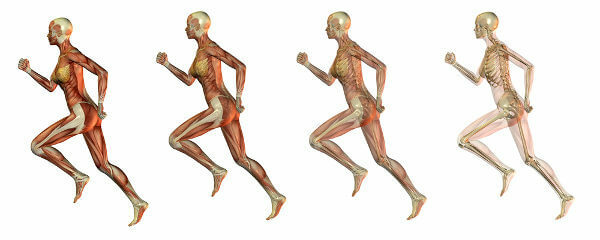
Bones and muscles work together, ensuring our locomotion.
→ human skeletal division
The human skeleton is divided into two parts: axial skeleton and appendicular skeleton. See below for more information about these two portions of the skeleton.

Note the parts that are part of the axial skeleton and those that are part of the appendicular skeleton.
axial skeleton
The axial skeleton is made up of 80 bones. They are part of the axial skeleton:
Skull: The skull is made up of facial bones and cranial bones. In general, these bones mainly ensure the protection of the brain, a portion of the central nervous system.
Hyoid bone: Bone without articulation located in the region between the mandible and the larynx, in the neck region.
Vertebrae: Bones that make up the spine. One of its primary functions is to ensure the protection of the spinal cord.
Ribs: Bow-shaped bones, found in the number of 12 pairs.
Sternum: Bone located in the anterior part of the chest, also known as the breast bone.
appendicular skeleton
The appendicular skeleton is made up of 126 bones, which form our limbs. Part of the appendicular skeleton are:
Upper limbs: The upper limbs are made up of the humerus (arm bone), ulna and radius (forearm bones), carpals (wrist bones), metacarpals (palm bones) and phalanges (finger bones).
Shoulder girdle: The shoulder girdle consists of the collarbone and the scapula.
Lower members: The lower limbs are made up of the femur (thigh bone), tibia and fibula (leg bones), patella (knee bone), tarsi, metatarsals and phalanges (finger bones).
pelvic waist: The pelvic girdle is made up of the hip bones, also called the pelvic bones.
→ skull bones
The skull has bones that, for the most part, are joined by immobile joints.. These bones are related to important functions of the body, such as protecting the brain and the speech and chewing process. This last function is made possible by the presence of the mandible.
The bones that make up the skull can be divided into two groups: facial and cranial bones.
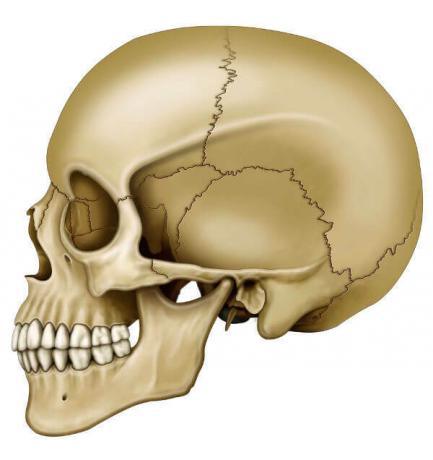
Most skull bones have immobile joints.
Cranial bones: parietal bones, storms, occipital, front, sphenoid, ethmoid, auditory ossicles and suture bones. The parietal and temporal bones are found in pairs. There are six auditory ossicles, and the suture bones have a varied number.
facial bones: jaws (two), zygomatics (two), nasal (two), tear (two), nasal shells (two), palatines (two), jaw and vomer. All bones are found in pairs, with the exception of the vomer and the mandible. It is worth noting that the jaw is the strongest bone in the face and also the longest. Furthermore, it is the only one that features a mobile articulation.
→ Spine
The vertebrae are the bones that form the spine.Between one vertebra and another, we find the intervertebral discs, which act as a real mattress between each of these bones.
Read too: Spinal Care
The spine plays fundamental roles for an individual's survival. It provides, for example, support for the body and protection for the spinal cord, a portion of the central nervous system.
In the spine, we observe seven cervical vertebrae, twelve thoracic, five lumbar, sacrum and coccyx. The sacrum is formed by the fusion of five vertebrae, while the coccyx is formed by the fusion of four vertebrae.
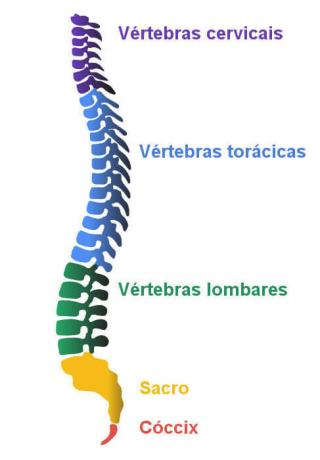
Look at the bones that make up our spine.
→ Upper limb bones
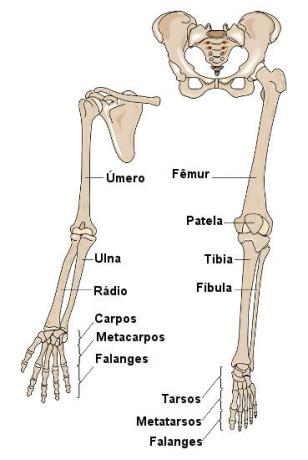
Note the bones that make up the lower and upper limbs.
The upper limbs are formed by the shoulder girdle, arm, forearm, wrist and hand. The shoulder girdle, responsible for ensuring the union of the upper limbs to the thorax, is formed by two bones: collarbone and scapula.
When we talk about arms, forearms, wrists and hands, we observe the following bones:
Humerus: Largest bone in the upper limb, being responsible for forming the arm.
Ulna and Radio: These two bones form the forearm. When we look at these two bones, we find that the ulna is the longest of them.
carpal bones: The carpal bones form our fist and represent a group of bones arranged in two rows of four bones. The carpal bones are called scaphoid, semilunar, pyramidal, pisiform, trapezoid, trapezoid, capitate and uncinate.
Pasterns: They are a group of five bones that make up the palm of the hand.
Phalanges: The phalanges, which are the bones that make up our fingers, are classified into: proximal, middle and distal phalanx. The thumb has two phalanges, while the other fingers of the hand have three phalanges.
→ Lower limb bones
The lower limbs are formed by the pelvic girdle, thigh, knee, shin, calf and foot. The pelvic girdle ensures the union of the lower limbs to the axial skeleton and is formed by the pelvic bones or hip bones.
The hip bones are formed from three bones: the ilium, ischium and pubis. When we talk about thigh, knee, shin, calf and foot, we observe the following bones:
Femur: Shape our thigh. It is the longest bone in the human body.
Patella: Bone that forms the knee.
Tibia: It is known as the cinnamon bone.
Fibula: It is known as the calf bone.
Tarsal bones: talus, calcaneus, navicular, cuboid, medial cuneiform, intermediate cuneiform and lateral cuneiform. The tarsal bones resemble the bones that make up our wrists.
Metatarsals: They are a group consisting of five bones.
Phalanges: the phalanges sIt's the bones that make up the fingers. The big toe (hallux) is formed by two phalanges, while the other toes are formed by three phalanges.
→ What are bones made of?
When asked what bones are made of, many quickly respond that they are made only of calcium and phosphate. However, unlike what many people think, the bones that make up the human skeleton are also formed by several cell types that belong to the bone tissue.
The cells found in bone tissue are osteocytes, osteoblasts and osteoclasts. Osteocytes are those located in cavities within the bone matrix. Osteoblasts, in turn, are responsible for secreting the organic part of the bone matrix. Osteoblasts, on the other hand, act by reabsorbing bone tissue, thus ensuring bone remodeling.
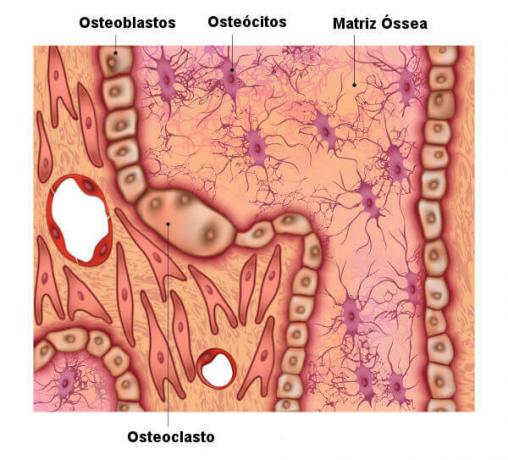
Bone tissue is responsible for forming bones.
Bone matrix is mineralized and ensures the tissue is strong. This matrix has an inorganic part and an organic part. The inorganic part is rich in phosphate and calcium, while the organic part has mainly collagen fibers.
By Ma. Vanessa Sardinha dos Santos
Source: Brazil School - https://brasilescola.uol.com.br/biologia/esqueleto-humano.htm
